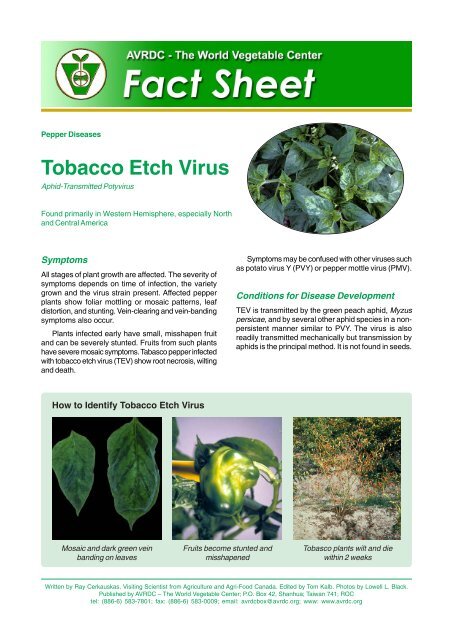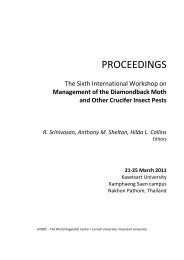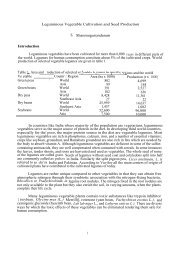Tobacco Etch Virus on Pepper
Tobacco Etch Virus on Pepper
Tobacco Etch Virus on Pepper
Create successful ePaper yourself
Turn your PDF publications into a flip-book with our unique Google optimized e-Paper software.
<strong>Pepper</strong> Diseases<str<strong>on</strong>g>Tobacco</str<strong>on</strong>g> <str<strong>on</strong>g>Etch</str<strong>on</strong>g> <str<strong>on</strong>g>Virus</str<strong>on</strong>g>Aphid-Transmitted PotyvirusFound primarily in Western Hemisphere, especially Northand Central AmericaSymptomsAll stages of plant growth are affected. The severity ofsymptoms depends <strong>on</strong> time of infecti<strong>on</strong>, the varietygrown and the virus strain present. Affected pepperplants show foliar mottling or mosaic patterns, leafdistorti<strong>on</strong>, and stunting. Vein-clearing and vein-bandingsymptoms also occur.Plants infected early have small, misshapen fruitand can be severely stunted. Fruits from such plantshave severe mosaic symptoms. Tabasco pepper infectedwith tobacco etch virus (TEV) show root necrosis, wiltingand death.World Vegetable CenterSymptoms may be c<strong>on</strong>fused with other viruses suchas potato virus Y (PVY) or pepper mottle virus (PMV).C<strong>on</strong>diti<strong>on</strong>s for Disease DevelopmentTEV is transmitted by the green peach aphid, Myzuspersicae, and by several other aphid species in a n<strong>on</strong>persistentmanner similar to PVY. The virus is alsoreadily transmitted mechanically but transmissi<strong>on</strong> byaphids is the principal method. It is not found in seeds.How to Identify <str<strong>on</strong>g>Tobacco</str<strong>on</strong>g> <str<strong>on</strong>g>Etch</str<strong>on</strong>g> <str<strong>on</strong>g>Virus</str<strong>on</strong>g>Mosaic and dark green veinbanding <strong>on</strong> leavesFruits become stunted andmisshapenedTobasco plants wilt and diewithin 2 weeksWritten by Ray Cerkauskas, Visiting Scientist from Agriculture and Agri-Food Canada. Edited by Tom Kalb. Photos by Lowell L. Black.Published by AVRDC – The World Vegetable Center; P.O. Box 42, Shanhua; Taiwan 741; ROCtel: (886-6) 583-7801; fax: (886-6) 583-0009; email: avrdcbox@avrdc.org; www: www.avrdc.org
C<strong>on</strong>trolResistant varieties are available. Check with yourextensi<strong>on</strong> agent for resistant varieties that are availablein your regi<strong>on</strong>.Use a nethouse or screenhouse with 32-mesh orfiner to keep out aphids and to grow seedlings fortransplant use. Use virus-free transplants.Minimize plant handling during the growing seas<strong>on</strong>to reduce the amount of virus spread mechanically.Remove nearby volunteer plants and solanaceousweeds from producti<strong>on</strong> fields, nearby ditch banks,hedges, fence-rows or other locati<strong>on</strong>s. Avoid growingother solanaceous crops especially pepper or tobacc<strong>on</strong>earby.Cultural practices include the use of organic (ie.sawdust, woodchips, and maize-cob mulches) mulchesor aluminum foil mulches to reduce aphid visits to plantsand thus delay virus spread. This results in reducedvirus incidence and increased yields.Plant earlier to avoid high aphid populati<strong>on</strong>s thatoccur later in the seas<strong>on</strong>. Late plantings should be setas far as possible from fields used to produce earlytomatoes and peppers, which act as sources of virusesand aphids.M<strong>on</strong>itor aphid populati<strong>on</strong>s early in the seas<strong>on</strong> andapply fast-acting insecticide treatments when neededsince aphids readily transmit the virus. Use mineral oilsprays to delay virus spread in the crop by interferingwith aphid transmissi<strong>on</strong> of the virus.Scout fields for the first occurrence of virussymptoms. If affected plants are found, spray them witha fast-acting insecticide first to prevent aphids frommigrating to nearby healthy plants. Remove the affectedplants, completely, and place in a plastic bag. Do nottouch other plants nearby with hands, tools or clothingto prevent mechanical transmissi<strong>on</strong> of the virus.Disinfect tools, stakes, and equipment before movingfrom diseased areas to healthy areas. This can be d<strong>on</strong>eby: 1) soaking 10 minutes in a 1:10 diluti<strong>on</strong> of a 5.25%sodium hypochlorite (household bleach), do not rinse;or 2) by cleaning in detergent at the c<strong>on</strong>centrati<strong>on</strong>srecommended for washing clothes or dishes. Keep allsoluti<strong>on</strong>s fresh. Hands may be washed with soap ormilk. Work in diseased areas last, after working inunaffected parts of a field. Wash clothing that comesinto c<strong>on</strong>tact with virus-infected plants with hot waterand a detergent.For more informati<strong>on</strong> <strong>on</strong> the producti<strong>on</strong> ofpepper and other vegetables, go to.AVRDC Publicati<strong>on</strong> 04-5882004
















